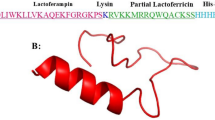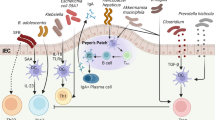Abstract
Oral administration of “immune milk”, that had been obtained from cows immunized with a variety of human gut bacteria containingE. coli, S. typhimurium, S. dysenteriae and 23 others, protected AKR/J mice from the lethal effect of radiation, when immune milk was orally given to mice at 150 g kg−1 day−1 for 7 days prior toγ-irradiation of 8 Gy. Mean survival times were 24.8 days for the group given immune milk but only 16.8 days for the group given control milk from unimmunized cows. Enterobac teriaceae were detected in various organs such as liver, lung and kidney on day 13 after irradiation, whereas the numbers were significantly fewer in the study group as compared with the control group. And fewer number of intestinal Enterobacteriaceae were detected in the study group compared with the control group prior to irradiation. Immune milk also enhanced the mitogenic response of mesentric lymph node cells, the redirected cytolytic activity of intestinal intraepithelial lymphocytes to P815 tumor cells with anti-CD3 mAb, andin vitro killing activities of the phagocytes in mesenteric lymph nodes toE. coli as compared with control milk. These results suggest that immune milk may reduce the number of bacteria translocating from the intestinal-tract and augment the activities of the gut-associated lymphoid tissues against the invasion of intestinal bacteria, causing protection against the lethal effect of radiation.
Similar content being viewed by others
Abbreviations
- CD:
-
cluster of differentiation
- Con A:
-
concanavalin A
- E. coli:
-
Escherichia coli
- FITC:
-
fluorescein isothiocynate
- GALT:
-
gut-associated lymphoid tissues
- IEL:
-
(intestinal) intrepithelial lymphocytes
- LPS:
-
lipopolysaccharide
- mAb:
-
monoclonal antibody
- MLN:
-
mesentric lymph nodes
- PBS:
-
phosphate buffered saline
- PE:
-
phycoerythrin
- PHA-P:
-
phytohemagglutinin P from Phaseolus vulgaris
- PP:
-
Peyer's patches
- SI:
-
stimulation index
- WPC:
-
whey protein concentrate
References
Kondo S. Molecular radiation biology. Univ. of Tokyo Press, Tokyo, 1972: 2.
Kishihara K, Yoshikai Y, Matsuzaki G, Tomooka S, Nomoto K. ‘Radioresistant’ intrathymic T cell precursors express T cell recpetor Cγ 4- and Cδ-specific gene messages. Eur J Immunol 1988; 18: 841–7.
Wilson BR. Survival studies of whole-body X-irradiated germfree (axenic) mice. Radiat Res 1963; 20: 477–83.
Anderson RE, Howart JL, Stone S. Acute response of germ-free and conventional mice to ionizing radiation. Arch Path 1968; 86: 676–80.
Hale ML, McCarthy KF. Effect of sublethal ionizing radiation on rat Peyer's patch lymphocytes. Radiat Res 1984; 99: 151–64.
Keelan M, Cheeseman C, Walker K, Thomson ABR. Effect of external abdominal irradiation on intestinal morphology and brush border membrane enzyme and lipid composition. Radiat Res 1986; 105: 84–96.
Mastromarino A, Wilson R. Antibiotic radioprotection of mice exposed to supralethal whole-body irradiation independent of antibacterial activity. Radiat Res 1976; 68: 329–38.
Yoshikai Y, Miake S, Sano M, Nomoto K. Increased susceptibility toEscherichia coli infection in mice pretreated withCorynebacterium parvum. Microbiol Immunol 1983; 27: 273–82.
Golay A, Ferrara JM, Felber JP, Schneider H. Cholesterol-lowering effect of skim milk from immunized cows in hypercholesterolemic patients. Am J Clin Nutr 1990; 52: 1014–9.
Tacket CO, Losonsky G, Link H, Hoang Y, Guesry P, Hilpert H, Levine MM. Protection by milk immunoglobulin concentrate against oral challenge with enterotoxigenicEsherichia coli. N Engl J Med 1988; 318: 1240–3.
Hilpert H, Brussow H, Mietens C, Sidoti J, Lerner L, Werchau H. Use of bovine milk concentrate containing antibody to rotavirus to treat rotavirus gastroenteritis in infants. J Infect Dis 1987; 156: 158–66.
American Institute of Nutriton, Report of the AIN ad hoc committee on standards of nutritional studies. J Nutr 1977; 107: 1340–8.
Goodman T, Lefrancois L. Intraepithelial lymphocytes. Anatomical site, not T cell receptor form, dictates phenotype and function. J Exp Med 1989; 170: 1569–81.
Petit A, Ernst PB, Befus AD, Clark DA, Rosenthal KL, Ishizaka T, Bienenstock J. Murine intestinal intraepithelial lymphocytes II. Comparison of freshly isolated and cultured intraepithelial lymphocytes. Eur J Immunol 1985; 15: 216–21.
Ballas ZK, Rasmussen W, Van Otegham JK. Lymphokine-activated killer (LAK) cells II. Delineation of distinct murine LAK-precursor subpopulations. J Immunol 1987; 138: 1647–52.
Sontoni A, Piccoli M, Ortaldo JR, Mason L, Wiltrout RH, Herberman RB. Changes in number and density of large granular lymphocytes upon in vivo augmentation of mouse natural killer activity. J Immunol 1985; 134: 2799–807.
Goodman T, Lefrancois L. Expression of the γ-δ T-cell receptor on intestinal CD8+ intraepithelial lymphocytes. Nature 1988; 333: 855–7.
Rodriguez-Ortega M, Ofek I, Sharon N. Membrane glycoproteins of human polymorphonuclear leukocytes that act as receptors for mannose-specificEscherichia coli. Infect Immun, 1987; 55: 968–73.
Boner G, Mhashilkar M, Rodriguez-Ortega M, Sharon N. Lectin-mediated, nonopsonic phagocytosis of type 1Escherichia coli by human peritoneal macrophages of uremic pateints treated by peritoneal dialysis. J Leukocyte Biol 1989; 46: 239–45.
Janeway CA. Frontiers of the immune system. Nature 1988; 333: 804–6.
Ferguson A. Mucosal immunology. Immunol Today 1990; 11: 1–3.
Kobayashi T, Ohmori T, Yanai M, Kawanishi G, Yoshikai Y, Nomoto K. Protective effect of orally administrating immune milk on endogenous infection in X-irradiated mice. Agric Biol Chem. 1991; 55: 2265–72.
Miake S, Nomoto K, Yokokura Y, Yoshikai Y, Mutai M, Nomoto K. Protective effect ofLactbacillus casei onPseudomonas aeruginosa infection in mice. Infect Immun 1985; 48: 480–5.
Nomoto K, Miyake M, Hashimoto S, Yokokura Y, Mutai M, Nomoto K. Augmentation of host resistance toListeria monocytogenes infection byLactobacillus casei. J Clin Lab Immunol 1985; 17: 91–7.
Author information
Authors and Affiliations
Rights and permissions
About this article
Cite this article
Ishida, A., Yoshikai, Y., Murosaki, S. et al. Administration of milk from cows immunized with intestinal bacteria protects mice from radiation-induced lethality. Biotherapy 5, 215–225 (1992). https://doi.org/10.1007/BF02171054
Received:
Accepted:
Issue Date:
DOI: https://doi.org/10.1007/BF02171054




